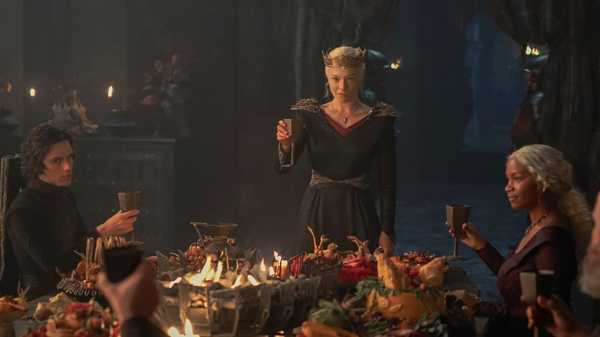
Save this storySave this storySave this storySave this story
The second season of “House of the Dragon” drew to a close on Sunday night with two major reversals. Rhaenyra Targaryen, the daughter and rightful heir of the deceased King Viserys, gained a pair of unexpected allies in Daemon, her uncle and husband, and Alicent, her childhood best friend turned stepmother. For much of the HBO series’ run, all three have been at odds. Daemon, Viserys’s vainglorious younger brother, had married his niece in part as a way to strengthen his own bid for the throne, and Alicent had pushed for the ascension of her immature firstborn, Aegon. The boy’s coronation, which amounted to a coup, divided the clan and the realm. But a prophetic vision of the coming trudge of the White Walkers into the Seven Kingdoms finally convinced Daemon that there was more to being king than displays of force, and the possibility that Alicent’s daughter could be conscripted into combat on dragonback helped her realize she’d have to fight to protect her children’s softness, too. The ensuing alliances, however tenuous, come with a thrill of chaotic possibility.
“House of the Dragon” is set two centuries before “Game of Thrones,” but it often feels more modern than its predecessor. By the time the events of the original show unfolded, the Targaryens seemed to belong to another age: a bygone era of dragon sightings, a near-extinct tongue, and royal incest as a matter of course. The dynasty was more legend than history—a perception that Daenerys leaned on as part of her claim to the Iron Throne. But the “Dragon” creator Ryan Condal’s attempt to learn from the earlier series’ shortcomings—and interest in the question of how rulers legitimate their reign—has yielded a new vision of the ancient house. Here, the anatomical focus has moved from the infamous bared breasts on “Thrones” to the vulnerabilities that attend the possession of a womb. Amid the intrafamilial drama, military might and strategic pacts are no longer enough to insure victory: any would-be sovereign will also need to win the hearts and minds of the people. Intimate tragedies are repurposed as public spectacle, as when Aegon is advised to use the murder of his infant son to garner sympathy from the “smallfolk.” Rhaenyra gets lessons in exercising the common touch from her new confidante and love interest, Mysaria, who once presided over a network of spies in low places at King’s Landing. In the end, Rhaenyra even proves willing to undercut the source of the Targaryens’s divine right of kings—their communion with dragons—by calling for riders from outside the legitimate royal lineage, recruiting bastards who come to embody the vox populi.
Still, the strongest elements of the new series are the ones that feel most like “Thrones.” Season 1, which rarely took viewers beyond the Targaryen keep, was a sombre, disjointed, decades-spanning affair. The current season was funnier and more focussed, even as it expanded its world. Condal introduced the kind of goofy yet poignant crowd-pleasing elements that “Thrones” tended to excel at, like the fight to the death between the identical-twin knights Arryk and Erryk, who’d pledged themselves to opposing royal factions. And then there were the two best additions to the cast, the witchy Alys Rivers (Gayle Rankin) and the chronically nonplussed Simon Strong (Simon Russell Beale), neither of whom could be arsed to put up with Daemon’s brooding self-importance.
These injections of life and levity don’t quite make up for the overarching inertia of the second season, in which two of the series’ three central characters didn’t do much of anything. Alicent’s arc was affecting, but Daemon’s was tiresome: his stay at the seemingly cursed Harrenhal castle was marked by a series of dreams and hallucinations that seldom provided new insight into his psychology. Rhaenyra, meanwhile, epitomized pragmatic restraint—an admirable quality in a leader and a lethal one in a protagonist. Westeros has traditionally been a place where well-meaning people sometimes need to do terrible things for the greater good, and hope that it doesn’t corrupt them in the process. But the show is so insistent on making Rhaenyra the only worthy candidate for the throne that it entraps her in a cage of likability. She speechifies endlessly about the cost of the civil war to her subjects, and seeks to rule in order to defend both her children and the realm against the cataclysmic threat of the White Walkers. To win, she’ll need to eliminate Aegon—but, after a horrific injury that leaves him questioning his will to live, his own mother has given Rhaenyra her blessing. The brutal pruning of the family tree might as well be a mercy killing.
“House of the Dragon” is most engaging when it drills into the human core of its succession crisis: the way Daemon’s personal relationships are warped by his political ambitions, or Alicent’s hard-won discovery that, if you spend your life propping up men, they’ll only see you as a prop. You don’t have to be the scion of a king to know that, when it comes to matters of inheritance, things can turn very ugly, very fast. The new allegiances in the finale satisfyingly blur the lines between the factions, but until war truly begins—and Rhaenyra embraces every aspect of leadership, including the unsavory ones—it’s still all table-setting, no meat. ♦
Sourse: newyorker.com